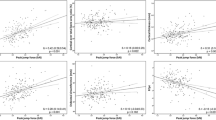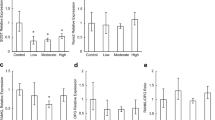Abstract.
To identify the genes, and the mechanisms that account for the 53% higher peak bone density in C3H/HeJ (C3H) mice compared with C57BL/6J (B6) mice, we are performing quantitative trait locus and phenotypic analyses. The phenotypic studies revealed differences in bone formation and resorption, and showed that hindlimb immobilization (by sciatic neurectomy) caused a greater increase in endosteal resorption in the tibiae of B6 compared with C3H mice. The current studies were intended to examine the hypothesis that the bones of C3H mice are less sensitive to mechanical loading than the bones of B6 mice. To increase mechanical loading, 9-week-old female B6 and C3H mice (n = 10–13 mice/group) were subjected to a jumping exercise (20 jumps/day, 5 days/week, to heights of 20–30 cm) for a total of 4 weeks. Control mice did not jump. Osteocalcin, alkaline phosphatase (ALP) activity, and IGF-I were measured in serum. The left tibiae were used for histomorphometry (ground cross-sections prepared at the tibio-fibular junction) and the right tibiae and femora were used for determinations of bone breaking strength (3-point bending). The results of these studies revealed (1) significant effects of both mouse strain (B6 and C3H) and the jumping exercise on tibial strength; (2) an exercise-dependent increase in serum IGF-I in C3H, but not B6 mice; and (3) no effects on serum ALP or osteocalcin. The histomorphometric analyses showed no effect of exercise on C3H tibiae, but significant exercise-dependent increases in total bone area, periosteal perimeter, periosteal mineral apposition rate (MAR), and periosteal bone formation (P < 0.02 for each) in B6 tibiae. There were no effects of exercise on periosteal resorption or any endosteal measurement in either C3H or B6 mice. Since the jumping exercise was designed to cause a two–three fold increase in muscular-skeletal loading at the tibio-fibular junction, and the calculated stress (g/mm2) at this sampling site was only 16% greater for B6 compared with C3H mice, we had anticipated that both strains of mice would show exercise-dependent increases in periosteal bone formation, with a greater response in the B6 mice. The lack of a response in the C3H tibiae demonstrates that the bones of C3H mice are less sensitive to mechanical loading (and unloading) than the bones of B6 mice.
Similar content being viewed by others
Author information
Authors and Affiliations
Additional information
Received: 21 July 1999 / Accepted: 2 November 1999
Rights and permissions
About this article
Cite this article
Kodama, Y., Umemura, Y., Nagasawa, S. et al. Exercise and Mechanical Loading Increase Periosteal Bone Formation and Whole Bone Strength in C57BL/6J Mice but Not in C3H/Hej Mice. Calcif Tissue Int 66, 298–306 (2000). https://doi.org/10.1007/s002230010060
Published:
Issue Date:
DOI: https://doi.org/10.1007/s002230010060




